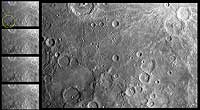|
COMETS EARTH JUPITER KUIPER BELT MARS MERCURY METEORITES NEPTUNE OORT CLOUD PLUTO SATURN SOLAR SYSTEM SPACE SUN URANUS VENUS ORDER PRINTS
PHOTO CATEGORIES SCIENCEVIEWS AMERICAN INDIAN AMPHIBIANS BIRDS BUGS FINE ART FOSSILS THE ISLANDS HISTORICAL PHOTOS MAMMALS OTHER PARKS PLANTS RELIGIOUS REPTILES SCIENCEVIEWS PRINTS
|
Related Documents
Download Options
This image of Mercury's surface was acquired during MESSENGER's first flyby of the planet on January 14, 2008, through the lens of the Narrow Angle Camera (NAC), part of the Mercury Dual Imaging System (MDIS). The image was acquired when MDIS was 11,588 km (7,200 miles) from Mercury's surface. Several processes have acted to sculpt Mercury's surface over time, and evidence of them is abundant in this image. This scene shows at least five different events in Mercury's surface history. The large crater to the lower left of the image measures ~230 km (143 miles) in diameter and has a prominent crater, about 85 km (53 miles) across, nestled inside it, south of its center. Both of these craters were subsequently filled with a material that appears to have been emplaced in a relatively fluid form, as evidenced by the fact that the material "embays" or onlaps the ejecta blanket surrounding the rim of the smaller crater. The larger crater is filled almost to its rim with this smooth plains material, which is thought to be of volcanic origin. Subsequent to the plains emplacement was the formation of the linear feature trending southwest to northeast across the lower half of the scene. This feature is a lobate scarp, similar to many others found on Mercury's surface, and thought to originate when compressional stresses crumpled the surface. The last major episode in the history of this region is the impact that formed the large crater at the top of the image. The formation of this crater resulted in impact-derived material, known as ejecta, being thrown out radially for large distances. Some of this ejecta formed chains of "secondary" craters as it impacted back onto the surface; some of these secondary craters are visible atop the lobate scarp. By careful examination of the relationships among features within images such as these, Mercury's surface history can be teased out, enabling us to better understand the evolution of this planet and other terrestrial worlds. |
